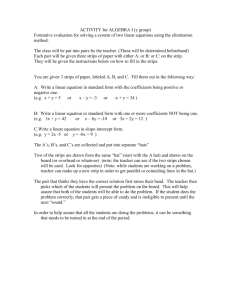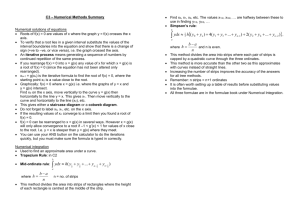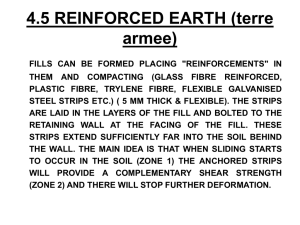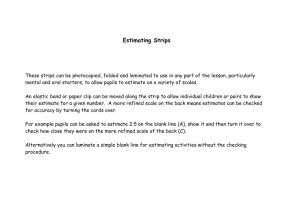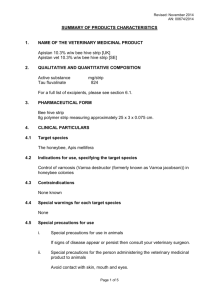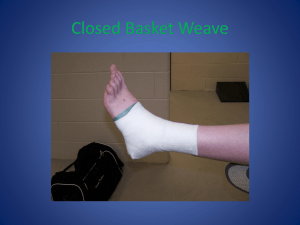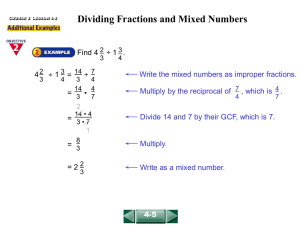20 The Mid-Ordinate Rule
advertisement
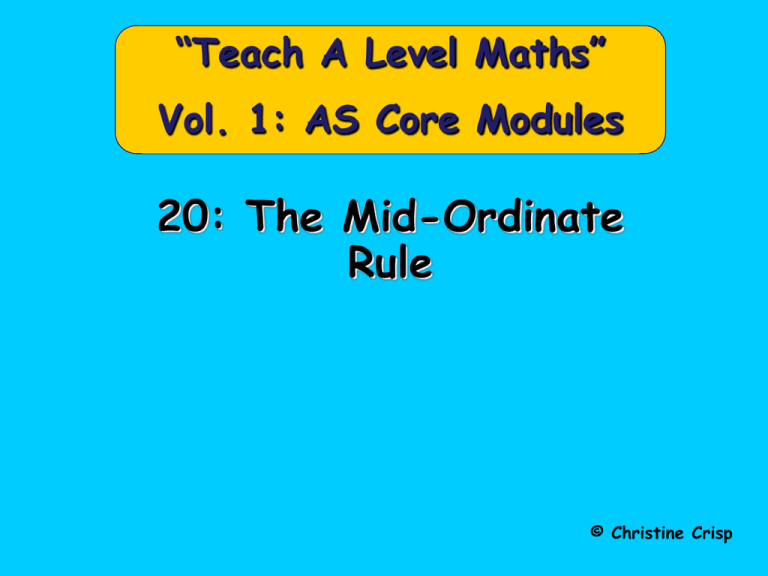
“Teach A Level Maths” Vol. 1: AS Core Modules 20: The Mid-Ordinate Rule © Christine Crisp The Mid-Ordinate Rule Module C3 AQA "Certain images and/or photos on this presentation are the copyrighted property of JupiterImages and are being used with permission under license. These images and/or photos may not be copied or downloaded without permission from JupiterImages" The Mid-Ordinate Rule To find an area bounded by a curve, we need to evaluate a definite integral. If the integral cannot be evaluated, we can use an approximate method. You have already met the Trapezium rule for doing this. This presentation uses another method, the mid-ordinate rule. The Mid-Ordinate Rule As before, the area under the curve is divided into a number of strips of equal width. However, this time, the top edge of each strip . . . is replaced by a straight line so the strips become rectangles. The Mid-Ordinate Rule As before, the area under the curve is divided into a number of strips of equal width. However, this time, the top edge of each strip . . . is replaced by a straight line so the strips become rectangles. The top of the rectangle is drawn at the point on the curve whose x-value is at the middle of the strip. The total area of the rectangles gives an approximation to the area under the curve. x1 The Mid-Ordinate Rule To find the area of a strip we need width height y Area h y h The width is h ( as in the Trapezium rule ) The height is y (the value of the function at the mid-point of the base) The total area is h ( y1 y 2 . . . y n ) The Mid-Ordinate Rule e.g.1 Use 4 strips with the mid-ordinate rule to estimate the value of 2 ln x dx 1 Give the answer to 4 d.p. Solution: y ln x Notice that the number of x-values is the same as the number of strips. The Mid-Ordinate Rule Area h ( y1 y 2 . . . y n ) ; n4 y ln x b a 1 x1 h 2 ba h 0 25 4 N.B. h x1 a 2 x1 1 125 x 1 125 1 375 1 625 1 875 y 0 11778 0 31845 0 48551 0 62861 2 So, ln x dx 1 0 25 ( y1 y 2 y 3 y4 ) 0 3876 ( 4 d.p. ) The Mid-Ordinate Rule SUMMARY The mid-ordinate rule for estimating an area is b a y dx h ( y1 y 2 y 3 . . . y n ) where n is the number of strips. ba The width, h, of each strip is given by h n ( but should be checked on a sketch ) The 1st x-value is at the mid-point of the width of the 1st h rectangle: x1 a 2 The number of ordinates is the same as the number of strips. The accuracy can be improved by increasing n. The Mid-Ordinate Rule Exercises 1. Estimate 2 1 1 x2 0 dx using the mid-ordinate rule with 4 strips, giving your answer to 3 d.p. How can your answer be improved? 2. Estimate 2 sin x dx using the mid-ordinate 0 rule with 3 strips. Give your answer to 3 s.f. N.B. Radians ! The Mid-Ordinate Rule Solutions 1. 2 1 1 x 0 2 dx n 4, h 05 x1 A h ( y1 y 2 y 3 y4 ) x 0 25 y 0 9412 0 75 1 25 1 75 0 64 0 3902 0 2462 A 0 5 ( y1 y 2 y 3 y4 ) 1 109 ( 3 d. p. ) The answer can be improved by using more strips. Solutions The Mid-Ordinate Rule 2 sin x dx 0 n 3, h 3 x y 6 0 25 x1 2 1 5 6 0.25 A h ( y1 y 2 y 3 ) 1 57 ( 3 s. f. ) The Mid-Ordinate Rule The following sketches show sample rectangles where the mid-ordinate rule under- and over-estimates the area. Under-estimates ( concave upwards ) Over-estimates ( concave downwards ) The blue shaded areas are not under the curve but are included in the rectangle. The red shaded areas should be included but are not. The Mid-Ordinate Rule The Mid-Ordinate Rule The following slides contain repeats of information on earlier slides, shown without colour, so that they can be printed and photocopied. For most purposes the slides can be printed as “Handouts” with up to 6 slides per sheet. The Mid-Ordinate Rule SUMMARY The mid-ordinate law for estimating an area is b a y dx h ( y1 y 2 y 3 . . . y n ) where n is the number of strips. ba The width, h, of each strip is given by h n ( but should be checked on a sketch ) The 1st x-value is at the mid-point of the width of the 1st h rectangle: x1 a 2 The number of ordinates is the same as the number of strips. The accuracy can be improved by increasing n. The Mid-Ordinate Rule e.g.1 Use 4 strips with the mid-ordinate rule to estimate the value of 2 ln x dx 1 Give the answer to 4 d.p. Solution: y ln x We need 4 y-values so we set out the calculation in a table as for the Trapezium rule. The Mid-Ordinate Rule Area h ( y1 y 2 . . . y n ) ; n4 y ln x b a 1 x1 h 2 ba h 0 25 4 N.B. h x1 a 2 x1 1 125 x 1 125 1 375 1 625 1 875 y 0 11778 0 31845 0 48551 0 62861 2 So, ln x dx 1 0 25 ( y1 y 2 y 3 y4 ) 0 3876 ( 4 d.p. ) The Mid-Ordinate Rule The following sketches show sample rectangles where the mid-ordinate rule under- and over estimates the area. Underestimates ( concave upwards ) Overestimates ( concave downwards )
